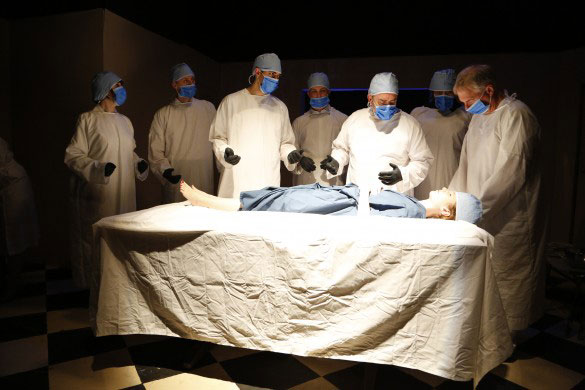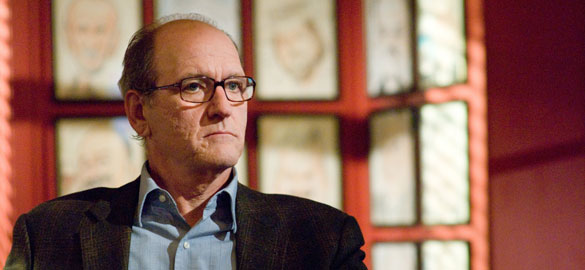
Indie theater is a tough business (like I really need to tell you that), so often there is a reliance on trotting out well-known classics in order to pack the house. Even Broadway isn’t immune to this either (when Kenneth Branagh brings his production of Macbeth to New York next year it will be the fourth major revival in less than a decade), so it’s refreshing to see an indie theater company — particular one that is already worthy of admiration like The Seeing Place — revive a rarely-produced eighty year-old Pulitzer Prize winning play. The Seeing Place made an excellent choice in reviving Sidney Kingsley‘s hospital drama Men In White, which not only is a great fit for the company’s strengths but is surprisingly timely with its focus on the stresses (both personal and economic) placed on medical professionals.
The play opens on St. George’s Hospital in New York City, a Depression-era hospital facing budgetary issues, seemingly in media res on a typical busy day, focusing on the young and ambitious Dr. George Ferguson (Brandon Walker). While Ferguson is currently studying under the hospital’s respected Dr. Leo Hochberg (Mark Gorham), he has grand plans of studying abroad after he marries his fiance Laura (Erin Cronican), who comes from a wealthy family. However, Ferguson entrenches himself into nearly every facet of the hospital, earning the ire of Dr. Cunningham (Brian Charles Rooney) for questioning his methods and the admiration of young nurse Barbara Dennin (Martine Moore), and his lack of free time displeases Laura. However, what’s wonderfully deceitful about Men in White is that this early melodrama spirals into very serious drama and social commentary on the economics of medical care in the 1930s (some of which sadly hasn’t changed much). In other words, don’t be fooled by the General Hospital nature of the early scenes between Ferguson and Laura.
The primary conflict is rooted in Dr. Ferguson’s attempts to balance his personal and professional lives while facing pressure from both. The Seeing Place has established a reputation for focusing on plays that are defined by internal conflict (for example, the last play they staged was Hamlet), and Walker, who is the Artistic Director of The Seeing Place and often the male lead of its productions, borrows from his portrayal of Hamlet in the internal struggle that Ferguson faces. However, in the performance I saw of Men In White Walker resisted any impulse to let his character become hysterical because of the pressure. It probably would have been easy to do so because of the source material’s melodramatic elements. Similarly, Cronican (who is the company’s Managing Director and also directed this production) allows her character to be a pillar of strength, which defies expectations of what audiences might think (likely wrongfully) of a 1930s woman. To add to that, the production wryly uses selections from Prokofiev’s Romeo & Juliet for much of its music, but this couple couldn’t be more different than Shakespeare’s famous young lovers.
However, though this play focuses on Ferguson’s conflict, one of the most impressive aspects of the production is the size of the cast — the ensemble includes sixteen actors portraying twenty-seven characters. That adds to the complexity and chaos of the hospital environment even though many of the characters are peripheral. It helps put faces to the pressure that Dr. Ferguson is facing. These characters add a lot of color to a presentation that by design (to reflect a real-life hospital) is made primarily up of drab colors. Some of the more noteworthy include Jim DiMunno as an elderly doctor whose profession has passed him by (DiMunno portrays him with considerable trembling) and Jessica Kelly who portrays both an outspoken nurse and, in a brief, but powerful scene, an almost-hysterical mother pleading with Dr. Ferguson to keep her child alive. Though most of the cast depict supporting characters, the style of The Seeing Place allows each actor some room to portray their characters “in the moment,” which means nobody is mailing it in no matter how small his or her part in the scene is. There are a lot of nuances one will miss if he or she isn’t paying attention to the entire stage.
Another notable aspect is the authentic medical equipment and the flat (by intention) lighting that “colors” the production. I’m particularly amazed that the production somehow found authentic-looking 1930s nurse outfits, which alone transports the audience back to the era the play was written in. Nicole McLaughlin is credited for “Costume Construction” in the program, so I’d assume she deserves the lion’s share of the credit. Whenever I see a production in the Sargent Theater I wonder how the company will make the space’s technical limitations work for them. Cronican and the production team outdid themselves by striving for an authentic environment in which to present their performance.
This allows the company to do what the Seeing Place always does best — act off each other’s performances. That’s because while there are different theories to acting and the performing a play (something else I don’t need to tell you), what I always enjoy about the Seeing Place is that the company puts the actors first. Its productions are always marked by an unbridled enthusiasm and raw talent that I don’t see on stage anywhere else.
Men In White runs at ATA’s Sargent Theater (314 W 54th Street, New York) until November 24. Performances run Wednesday through Sunday. Check out www.seeingplacetheater.com for more information.



